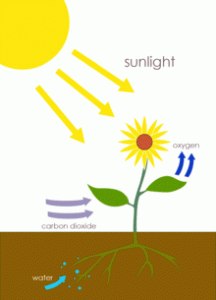Christmas has always been my favorite time of year. Over winter break while shopping for a christmas tree I was surprised by the size and health of the evergreen trees. Almost 500 massive, thick, green trees soared into the air waiting to be put in someones living room. This got me thinking about the evolution of trees as global warming increases. It is obvious that our environment is not as healthy as it used to be. Pollutants fill the air and heat up the earth more and more each year. I asked myself, what effect has this had on trees over the past decades? I concluded that the increase of pollutants in our atmosphere, such as CO2, most likely deter the growth of trees. However, what I found was quite surprising.

An article posted in The Telegraph claims that plants and trees are actually growing faster as a result of the increased carbon dioxide levels in the air. Since plants survive by converting CO2 into protein through photosynthesis, more CO2 in the air should mean healthier plants. Professor Martin Perry, head of plant science at Rothamsted research, believes that “There is no doubt that the enrichment of air with CO2 is increasing plant growth rates in many ares.”
The Telegraph article also includes a study done by the University of Leeds on tree growth over time. The team measured the girth of 70,000 trees across Africa and compared them to similar data collected four decades ago. What they found was that trees had been getting bigger and growing faster as time progressed, all while being in an environment that gained .6 tons of CO2 per year. This correlational study does not prove that increased CO2 causes tree growth, but it shows that greenhouse gases have not negatively effected trees. This study was only done on one specific area, however the sample size is large enough to convince me that it is no coincidence. We can rule out reverse causation, however it is possible that a confounding variable causes CO2 increase and improves tree growth.
it is no coincidence. We can rule out reverse causation, however it is possible that a confounding variable causes CO2 increase and improves tree growth.
According to the Food and Agriculture Organization there are actually more trees today than there were 100 years ago. The FAO explains that tree growth has exceeded harvest almost every year since the 1920’s, our current forest volume is 380% greater than it was at this time. What makes this important in contradicting my claim is the fact that CO2 levels (http://myweb.wwu.edu/dbunny/pdfs/CO2_past-century.pdf) have increased by 600 billion metric tons since 1920, the same year this study was conducted. CO2 levels directly correlate with the increase in tree population, providing a reason to believe that they are causal. Like the first study, this correlation could be caused by a confounding variable such as rainfall, sunlight, or human activity. However, it is enough to prove that my original claim was false.
Both studies give sufficient evidence to conclude that CO2 levels do not negatively effect tree growth. In fact, it is more likely that they actually improve the health and size of trees. With so much focus on the negative impact of increased green house gases, it is interesting that they have some benefits too.

As you stated, it is interesting to see a positive effect of climate change. I wonder if these “benefits” apply for the long run as well and it would be nice to see if there was a longitudinal study that explored if the results were the same over a few decades. Something that also might be cool to look into is if the healthier trees can now produce more oxygen for humans to breath? If so, it would almost seem as climate change was benefiting humans in the long run.
I am very surprised at the findings of this article. All you hear about is the loss of rain forests but that seems to be caused by human activity. In your post, you mentioned green house gases having benefits to the plants. Do you think its possible that the increased global sunlight and temperature over the years is what has increased tree growth, and not the actual green house gases themselves?